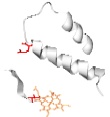Within the Bacillus subtilis genome, a novel monooxygenase was discovered which revealed a similarity of 76% to the well-known cytochrome P450 BM-3 (CYP102A1) of B. megaterium. Both enzymes are natural fusion proteins consisting of a heme and a FAD/FMN reductase domain. We here report the laboratory evolution of B. subtilis enzyme CYP102A3 leading to a different hydroxylation pattern. The regioselectivity of this enzyme which is similar to that of B. megaterium CYP102A1 was changed to hydroxylate n-octane not only in subterminal but also in terminal position. A double mutant was prepared that produces 48% 1-octanol and 52% of secondary octanoles. For the screening procedure, a new HTS assay was developed that is able to discriminate between terminal and subterminal hydroxylation of carbon chains.
